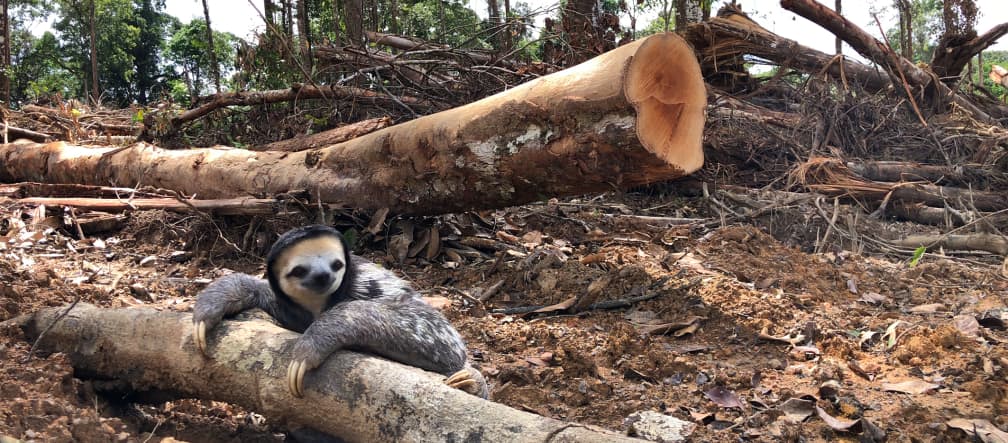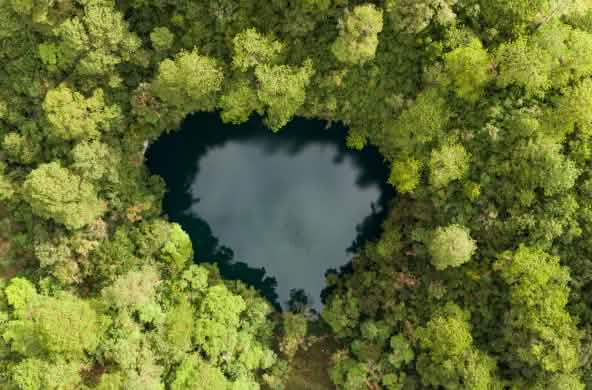
Completed campaign
Amazonia: NO to deforestation for biomass power plants in French Guiana!
France is lobbying the EU intensively to build new biomass power plants in French Guiana. One of its goals is to supply energy to the European Space Center in Kourou and to develop biofuels for the space industry. This project is a threat to the Amazon rainforest and the people of South America.
News and updatesTo: the French government, European Parliament, European Commission, EU Council of Ministers and elected representatives of the Guiana local authority
“Hands off the Amazon rainforest: Do not soften up the EU’s Renewable Energy Directive for biomass power plants in French Guiana!”The environmental organization Maïouri Nature Guyane has issued an alert pointed out that French MEPs have introduced a derogation in the EU Renewable Energy Directive. Its purpose is to circumvent EU standards for sustainability and the mitigation of greenhouse gas emissions, with the goal of increasing the production of wood as fuel for new biomass power plants in French Guiana.
The French government is already working on an executive order to accelerate the development of the biomass industry in the French overseas territory in South America.
The Amazon rainforest thus faces deforestation in the name of “green energy”. The cleared forest areas would then be converted into industrial plantations for the production of wood or other plant biomass as fuel.
The European Space Agency (ESA) and the French Space Agency (CNS) are planning to build two biomass power plants that would consume 120,000 tons of wood annually to supply energy to the space center in Kourou as a cost-cutting measure.
Environmental organizations and scientists are calling on the EU and its member states to stop recognizing wood from forest clearing as a climate-neutral renewable energy source and to stop subsidizing the burning of wood.
Cutting down trees and burning entire forests in power plants increases CO2 emissions, fuels the global climate crisis and destroys ecosystems and biodiversity. In doing so, France and the EU would be undermining their own climate protection and conservation goals.
Furthermore, the projects threaten the rights of the Indigenous peoples of Guiana and access to land for smallholders.
The European Parliament, the European Commission and the Council of Ministers will soon be negotiating the Renewable Energies Directive. For the sake of the Amazon rainforest, we need to act now to stop this destructive derogation.
French Guiana
French Guiana is a French overseas department in South America, part of the European Union and part of the Amazon rainforest. With an area of 83,825 km², it is roughly the size of the island of Ireland, but very sparsely populated with around 300,000 people, most of whom live on the Atlantic coast.
French Guiana is financially and economically dependent on France. The European Space Agency (ESA), which operates a spaceport in Kourou, is a major employer and of great importance to the department's economy.
Biodiversity in French Guiana
More than 90 percent of French Guiana is still covered with various types of highly biodiverse tropical rainforests, of which about 96 percent are primary forest. Mangrove forests extend along the coast.
1,660 tree species have been identified in French Guiana to date. The number of described vascular plants is 5,500 species.
The fauna is also very diverse: 367 freshwater fish, 135 amphibian, 167 reptile, 711 bird and 217 mammal species have been scientifically recorded there. The number of insects and other arthropods is estimated at 400,000 to one million species, although the real number is likely to be much higher1.
Preserving the Earth’s rainforests and biodiversity are crucial to combating the global climate crisis and preventing extreme weather events. The primary forests and other ecosystems in French Guiana make a vital contribution to this.
The greatest threats to the nature of French Guiana are industrial logging, gold mining and infrastructure projects such as the construction of roads (e.g. between Cayenne and Saul and between Saint-Laurent and Maripasoula) and hydroelectric power plants, whose reservoirs submerge large areas of forest. Deforestation for agricultural activities has so far been very low.
Power generation in French Guiana
The installed capacity for power generation in French Guiana is over 200 MW. Hydropower currently accounts for the largest share at 120 MW, resulting in hundreds of square kilometers of rainforest being submerged in the reservoirs. A significant share is generated by two fossil oil power plants of the French energy group EDF (Centrale Thermique de Kourou with 20 MW and Centrale Thermique Dégrad-des-Cannes with 20 MW). There are also several photovoltaic parks, including two plants that have been operated by Albioma in Kourou (12 MW) and in Matoury (4 MW) for more than ten years2.
According to French government plans, biomass power plants with a capacity of 40 MW and 60 MW will be built in French Guiana in 2023 and 2028 respectively3. By 2030, 30 percent of the department's energy is planned to come from biomass power plants. The volume of biomass required for this is estimated at nearly 800,000 tons in 2030.
European Space Center in Kourou
The European Space Center in Kourou consumes about 20 percent of French Guiana’s electricity. To reduce costs and become independent of the local power grid, the European Space Agency (ESA) and the French Space Agency (CNS) would like to build two biomass power plants in addition to photovoltaic plants (planned capacity: 10 MW)4.
For this purpose, the French company IDEX Services plans to build two biomass power plants with an electrical capacity of 9.1 MW and a thermal capacity of 9.1 MW (cooling in the form of chilled water for the industrial facilities of the space center). The total investment is expected to amount to 120 million euros. 120,000 tons of wood from Guiana are to be burned annually in the two power plants5.
Biomass power plants using agricultural waste and wood
In recent years, several biomass power plants have already been built and commissioned in French Guiana, using bagasse and other agricultural residues as well as waste from the timber industry and sawmills. This already fully utilizes the amount of waste available in French Guiana, which is why wood is planned as the fuel for the new plants.
The smallest of these biomass power plants has been in operation since 2009 in Kourou (1.7 MW). In late 2020, another biomass power plant was commissioned in Cacao (5.1 MW), while a further biomass power plant is apparently still under construction in d’Iracoubo (5.1 MW). A biomass power plant in Sinnamary (10.6 MW) recently began burning wood residues from submerged trees recovered from the reservoir (365 km2) of the Petit Saut hydroelectric power plant (116 MW) operated by the EDF energy group6. The operator of the four biomass power plants is Voltalia, a French energy group7.
The operator IDEX is building a biomass power plant in Montsinéry-Tonnégrande (6 MW), which is scheduled to go into operation in 2023 and consume 57,000 tons of biomass per year8 9 10.
Power plants using “liquid biomass”
Several power plants are apparently planned that will be run on “liquid biomass” (vegetable oil or biofuels). These include Le Larivot (120 MW), which the French energy company EDF is planning in a mangrove forest and which is to supply the capital Cayenne with power11.
There has been strong criticism of this project, in part because the plans called for the use of soybean oil as fuel12. To produce the oil needed to run the power plant, hundreds of square kilometers of rainforest would have to be cut down. Soybean cultivation is the main cause of the destruction of natural ecosystems in South America. Rapeseed oil imported from Europe is apparently also being discussed as a fuel for Le Larivot13.
In late July 2021, a judge for interim injunctions from the Administrative Court of Cayenne suspended the environmental permit for EDF’s Le Larivot power plant, writes the French government in a press release14. Since the power plant project is deemed crucial for energy security in French Guiana, the government, as the project promoter, decided to challenge the judge’s decision and appeal to the Council of State in cassation.
An application has been filed for another liquid biomass power plant by ALBIOMA S.A.S. at Saint Laurent du Maroni (12 MW)15.
Table 1: Existing and planned biomass power plants in French Guiana (author: Rainforest Rescue / Rettet den Regenwald e.V., sources 4 to 15)
| # | Location | Operator | Capacity in MW | Start of operation | Fuel |
| 1 | Kourou | Voltalia | 1.7 | 2009 | Wood |
| 2 | Cacao | Voltalia | 5.1 | 2022 | |
| 3 | Sinnamary | Voltalia | 10.6 | 2022 | Wood from reservoir |
| 4 | d’Iracoubo | Voltalia | 5.1 | ? | |
| 5 | Montsinéry-Tonnégrande | IDEX | 6.0 | 2023 | 57,000 t/a |
| 6 | ESA Kourou | IDEX | 9.1 electr. | 2024 |
120,000 t wood |
| 7 | ESA Kourou | IDEX | 9.1 thermal | 2025 | |
| 8 | Le Larivot | EDF | 120 | ? | Liquid biomass, e.g. rapeseed oil |
| 9 | Saint Laurent du Maroni | ALBIOMA | 12.0 | ? | Liquid biomass |
| TOTAL | 160.5 |
Derogation to Renewable Energy Directive introduced
The derogation for French Guiana and other “outermost regions” of the EU16 introduced by French MEPs in the EU Renewable Energy Directive (RED III) would not only allow thousands of hectares of biodiverse rainforests in French Guiana to be cleared and converted into industrial timber plantations for energy purposes, but also allow these activities to be financed through state aid.
Furthermore, the derogation not only covers solid biomass (wood, agricultural residues and waste) for power plants, but also “bioliquids ... and biofuels especially used in the space sector and related astrophysics activities”. What exactly is meant by this has not yet been made public.
Urgent action is required to stop the derogation from being confirmed by the European Commission and the EU Council of Ministers. On February 7, 2023, trilogue negotiations will be held on this topic with the European Parliament, during which a decision could already be made.
Sources:
1 Maïouri Nature Guyane 2023. DOSSIER BIOMASSE GUYANE. Alerte sur la refonte RED III et dérogation biomasse ligneuse primaire en Guyane: https://drive.google.com/file/d/19o5FGsMTu2nBIU3Qfnb6y8XYtmIm3HF4/view
2 Albioma (undated). Nos implantations. Guyane: https://www.albioma.com/implantation/guyane/
3 Republic of France 2020. Biomasse: https://guyane.ademe.fr/expertises/energies-renouvelables/biomasse
4 ESA (2020). ESA and CNES choose renewable energy to power Europe’s Spaceport:https://www.esa.int/Enabling_Support/Space_Transportation/ESA_and_CNES_choose_renewable_energy_to_power_Europe_s_Spaceport
5 IDEX 2022. Idex fait l'acquisition de deux projets de centrales de cogénération biomasse à Kourou en Guyane:https://www.idex.fr/nos-actualites/idex-fait-lacquisition-de-deux-projets-de-centrales-de-cogeneration-biomasse-kourou-en-guyane
6 TV Guyane 1. 2022. Le projet de la future plus grande centrale de biomasse de Guyane, à Petit Saut, est sur le point d'aboutir: https://la1ere.francetvinfo.fr/guyane/le-projet-de-la-future-plus-grande-centrale-de-biomasse-de-guyane-a-petit-saut-est-sur-le-point-d-aboutir-1223106.html
7 Voltalia 2021. Electricity production certified by the PEFC label for the Kourou biomass plant in Guyana: https://www.voltalia.com/news-releases/news-release-details/electricity-production-certified-pefc-label-kourou-biomass-plant/
8 TV Guyane 1 2022. En construction la centrale biomasse de Montsinéry-Tonnégrande sera opérationnelle en 2023: https://la1ere.francetvinfo.fr/guyane/centre-littoral/en-construction-la-centrale-biomasse-de-montsinery-tonnegrande-sera-operationnelle-en-2023-1306776.html
9 IDEX 2022. Idex soutient la transition énergétique du territoire guyanais: https://www.idex.fr/nos-actualites/idex-soutient-la-transition-energetique-du-territoire-guyanais
10 TV Guyane 1. 2021. La société Idex construit une centrale de biomasse pour l'électricité à Montsinéry-Tonnegrande: https://la1ere.francetvinfo.fr/guyane/la-societe-idex-construit-une-centrale-de-biomasse-pour-l-electricite-a-montsinery-tonnegrande-1169545.html
11 EDF PEI 2021. LA CENTRALE DU LARIVOT. Une centrale électrique 100% renouvelable épondant aux besoins énergétiques de la Guyane:https://www.centraledularivot.fr
12 Mongabay 2020. French Guiana soy biofuel power plants risk massive Amazon deforestation: https://news.mongabay.com/2020/12/french-guiana-soy-biofuel-power-plants-risk-massive-amazon-deforestation/
13 Guyaweb 2023. BIOMASSE : DES DÉROGATIONS ET BEAUCOUP D’INCONNUES: https://www.guyaweb.com/actualites/news/societe/biomasse-des-derogations-et-beaucoup-dinconnues/?
14 Republic of France, Ministry of the Environment 2021. Centrale électrique du Larivot en Guyane: https://www.guyane.gouv.fr/Publications/Salle-de-presse/2021/Aout-2021/Centrale-electrique-du-Larivot-en-Guyane
15 Republic of France, Ministry of the Environment 2023. Demande Projet centrale de combustion de 12MW fonctionnant à biomasse liquide ST Laurent-du-Maroni: https://www.guyane.gouv.fr/Actions-de-l-Etat/Environnement-Energie-et-Amenagement/Environnement/Autorite-environnementale/Examens-au-cas-par-cas/2023/Demande-Projet-centrale-de-combustion-de-12MW-fonctionnant-a-biomasse-liquide-ST-Laurent-du-Maroni
16 European Parliament 2022. TEXTS ADOPTED: https://www.europarl.europa.eu/doceo/document/TA-9-2022-0317_EN.pdf
Page 63:
(gb) paragraph 13 is replaced by the following:
‘13. For the purposes referred in ▌the first subparagraph of paragraph 1 of this Article, Member States may derogate, for a limited period of time, from the criteria laid down in paragraphs 2 to 7 and 10 and 11 of this Article by adopting different criteria for:
(a) installations located in an outermost region as referred to in Article 349 TFEU to the extent that such facilities produce electricity or heating or cooling from biomass fuels and bioliquids, and for biofuels especially for the space sector and related astrophysics activities; and
(b) biomass fuels and bioliquids used in the installations and biofuels especially used in the space sector and related astrophysics activities referred to in point (a) of this subparagraph, irrespective of the place of origin of that biomass, provided that such criteria are objectively justified on the grounds that their aim is to ensure, for that outermost region, access to safe and secured energy and incentivise the transition from fossil fuels to sustainable biomass fuels and bioliquids.
Bioliquids, biofuels and biomass fuels produced from primary woody biomass extracted in a sustainable manner and resulting from land use planning in an outermost region where forests cover at least 90% of the territory of that outermost region shall be taken into account for the purposes referred to in point (a), (b) and (c) of the first subparagraph of Article 29.
In order to ensure energy security in the outermost regions, Member States may continue to grant support to the production of electricity from forest biomass in electricity-only-installations located in outermost regions as referred to in Article 349 TFEU. [Am. 33]’
To: the French government, European Parliament, European Commission, EU Council of Ministers and elected representatives of the Guiana local authority
Ladies and Gentlemen,
French MEPs and the French government plan to accelerate the construction of new biomass power plants in French Guiana and enable the development of biofuels, particularly for use in the space sector.
To this end, they have introduced a derogation in the EU Renewable Energy Directive and are developing an executive order in France that would allow the use of wood from legal logging of the Amazon rainforest and the conversion of the land into timber plantations or agricultural monocultures for the cultivation of biomass for energy purposes.
We ask you to reject the derogation for French Guiana and other overseas territories, as well as the executive order:
Wood from the clearing of the Amazon rainforest is NOT a climate-neutral source of renewable energy, nor is biomass grown on the cleared areas for the production of biofuels. In doing so, France and the EU are undermining their own climate goals, their policies against global deforestation, and the conservation of ecosystems and biodiversity.
Yours faithfully,
How the climate and rainforests are linked
Rainforests are complex ecosystems in which a vast number of animal, plant and fungi species are tightly interdependent. They play a major role in the local and global climate: In a process called photosynthesis, plants absorb the greenhouse gas carbon dioxide (CO2) from the air. With the help of water and sunlight, they form sugar and from it other plant building blocks. In doing so, plants sequester carbon in stems, leaves and roots while releasing oxygen into the atmosphere.
According to studies, rainforests sequester 250 billion tons of CO2, much of it in peat forests. Globally, this is equal to 90 times the man-made greenhouse gas emissions per year.
Rainforests themselves produce a large part of the high year-round rainfall they receive. Evapotranspiration, i.e. the moisture that the plants release through their leaves, is an important aspect here. The forests are hot and humid, but the clouds reflect much of the sunlight back into space – thus cooling the atmosphere. Without this effect, the areas would be even warmer.
As carbon sinks and rainmakers, intact forests play an important role in regulating the climate and are crucial to the fight against catastrophic climate change.
The problem: catastrophic climate change and forest destruction
Rainforests are increasingly unable to act as climate stabilizers: When they are destroyed for plantations, grazing area or mining projects, vast amounts of greenhouse gases are released. For example, forest fires in Indonesia accounted for one-third of total global emissions in 1997. The loss of peat forests is particularly devastating.
According to a study published by Nature, rainforests could tip from carbon sinks to carbon emitters solely due to changing climatic and growth conditions from 2035 onward – thus accelerating catastrophic climate change.
Because of the intricate interdependencies of the rainforest ecosystem, the entire web can suffer if it is damaged in one place. Take the water cycle, for example. If drier periods occur as a result of global climate change – and this is already being observed – the cycle may break down. This can lead to evergreen, lush rainforests becoming grasslands with far lower biodiversity. The local climate would become drier and hotter.
The 18 tipping points in the climate system are particularly ominous: If, for example, climate change in the Amazon region reaches a certain point, the process and the loss of the rainforest in its current form will become unstoppable.
One thing is clear: catastrophic climate change is man-made. 98 percent of the scientists who study climate issues agree. Because the climate is a highly complex system, researchers are constantly discovering new relationships, interpreting data in different ways and revising forecasts. This is completely normal in science. However, the findings of climatologists are becoming increasingly alarming.
The solution: rainforest protection is climate protection
Rainforests must be preserved because they are indispensable as carbon sinks and their further destruction would worsen the impact of catastrophic climate change. Climate protection is therefore rainforest protection and vice versa.
- We need to preserve forests and nature and heal damage. Forests are more than just carbon sinks – they are diverse ecosystems and home to millions of people.
- We need to protect the climate while preserving biodiversity. Catastrophic climate change and extinction are two existential crises that we must tackle together.
- We need to secure and strengthen the rights of indigenous peoples, who are often the forest's best stewards: We call it the rainforest – they call it home.
- We need to fundamentally change our way of life and how we do business: This will mean reducing our consumption of energy, food and raw materials instead of maintaining it by turning to “green products”. We must stop burning fossil fuels.
- We need to reform flawed climate policy: We must end the misguided use of biofuels, especially if they are based on palm oil, soy or sugar cane, and stop burning trees in power plants.
- We reject offset programs as a modern “indulgence trade” in which companies finance environmental protection measures in return for being allowed to pollute. We also reject supposedly more climate-friendly “bridge technologies” like replacing coal with natural gas.
- In the wake of the Covid pandemic, we need to rebuild the economy and society in an environmentally sound way. There must be no economic “stimulus programs” based on old formulas.
Open letter of organizations from French Guiana "France has no lessons to give on how to protect tropical forests": https://www.regenwald.org/files/de/ONE_forest_in%20Guyane_English_ok.pdf
Maïouri Nature Guyane 2023. Energie biomasse: La France veut raser la forêt amazonienne
de Guyane pour faire "décoller" des fusées bio?: https://sites.google.com/site/maiourinature/fusee-bioMaïouri Nature Guyane 2023. FRENCH GUIANA BIOMASS FILE. Alert on RED III recast and primary woody biomass derogation in Guiana: https://drive.google.com/file/d/1a5r91WaF7YNRRZ9MfQtcTxazSuXhmmRn/view
Directive (EU) 2018/2001 on the promotion of the use of energy from renewable sources (also known as the Renewable Energy Directive – RED).
European Parliament 2022. TEXTS ADOPTED: https://www.europarl.europa.eu/doceo/document/TA-9-2022-0317_EN.pdf
Page 63: (gb) paragraph 13 is replaced by the following: ...
Government of France 2022. Projet de décret définissant des dérogations aux critères de durabilité et de réduction des émissions de gaz à effet de serre des combustibles ou carburants solides et gazeux issus de la biomasse s’appliquant dans les territoires d’outre-mer: https://www.consultations-publiques.developpement-durable.gouv.fr/projet-de-decret-definissant-des-derogations-aux-a2786.html
IDEX 2022. Idex fait l'acquisition de deux projets de centrales de cogénération biomasse à Kourou en Guyane: https://www.idex.fr/nos-actualites/idex-fait-lacquisition-de-deux-projets-de-centrales-de-cogeneration-biomasse-kourou-en-guyane
ESA (2020). ESA and CNES choose renewable energy to power Europe’s Spaceport: https://www.esa.int/Enabling_Support/Space_Transportation/ESA_and_CNES_choose_renewable_energy_to_power_Europe_s_Spaceport
Woodwell Climate Research Center 2021. Letter Regarding Use of Forests for Bioenergy: Hundreds of scientists affirm that trees are more valuable alive than dead — both for climate and for biodiversity:https://www.woodwellclimate.org/letter-regarding-use-of-forests-for-bioenergy/
Cut Carbon Not Forests 2022. Scientists urge end to burning forest biomass for energy
for sake of nature and biodiversity. Join fellow scientists in calling for an end to industrial-scale forest biomass: https://www.cutcarbonnotforests.org/scientist-letter-read/


